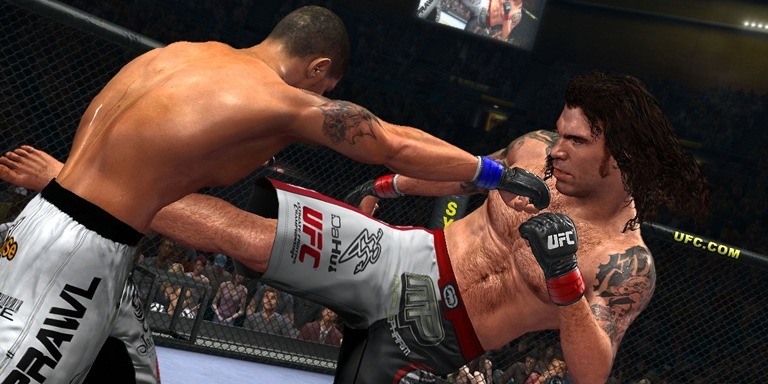Qualms about online matchmaking and career blandness persist from the first game, but hand the second controller to a friend and this title becomes a consummate couch-filler.
On starting the game, the first noticeable thing is the length of time it takes to complete the caching/loading menu process, which is up to 20 or 25 seconds in some instances. I checked this with friends in case my disk was scratched, but they have the same patience problems. The waiting is a little dull and the boredom could be alleviated with a little flavour text: I know a number of potential buyers are going to be interested in fighters’ backgrounds and the like. Having said that, my main problem with a game is usually in its play, so this perhaps speaks to the game’s quality in other areas.
A fighting game’s enjoyment should stem from how well a player’s movements translate into on-screen actions, and UFC 2010 does not disappoint in its faithfulness to real-world pugilism. The ring fighter’s arsenal combines flashy, quick strikes to his opponent with lumbering, boxer-like lunges and awkward wrestling take-downs. As with the previous instalment, UFC 2010 lovingly replicates the excitement of the speedier fighters and the power of the heavyweights: Mike Swick feints from cumbersome crosses and Frank Mir absorbs blows like a galleon.
Having seen the differences between the five weight divisions so well illustrated, I would have liked to see a sandbox mode where competitors from opposite classes could use their strengths to cause upsets or assert their strength. However, this doesn’t seem to fit with the promotion’s desire to appear clean-cut and professional.
Competitors such as Strikeforce have healthy and popular women’s divisions as well contested as the men’s, pound for pound, and their absence can make a lengthy evening of UFC 2010 as gruelling as its TV counterpart. This is reinforced by the game’s audio and visual style: the choice of venue and referee has been added, although this changes nothing to what can become a graphically bland game.The weigh-inThere hasn’t been much of a change from the last instalment in terms of how the fighters are modelled, although there has been attention paid to their idiosyncratic movements. Heavier fighters can borrow from the move set of a lighter competitor, but their versions of these actions (a weave or switch to southpaw stance, for example) are not generic as in the last instalment. Another change I was glad to see was that a fighter’s gum shield will not automatically go flying with every knockout. This is saved for show-stopping moments, which can be needed after a taught, technical half-hour’s wrestling.
A barrage of blows induce a “rocked” state in the fighter taking the punishment, and a “gassed” state of growing tiredness in the one throwing the punches and kicks. Rocking is denoted by screen changes and physical cues in much the same way as before. However, I did notice that the instances of this are fewer or less serious than in UFC 2009. This perceived change makes weak players like me a bit more gung-ho, becoming fodder for online opponents. Having said that, an improved tutorial system makes me feel a bit more confident about taking on all-comers, even as the button system has changed to become even harder to pick up and play (well).
It takes so long to load characters and their personalisation that I didn’t bother much with these options in the Career mode. More casual players can use a randomisation function to create their own fighter, which takes a lot of the pain out of the loading process. I found the front end of the subsequent fighter’s diary to be a little basic, and would have liked to have seen more interaction with the biggest names in the competition. Those interviews, features and conversations which do occur during the career seem a little characterless. This might be the case with many martial artists but a few more gimmicks would have left my UFC tenure seeming much less isolated. Otherwise, the interface is clear and easy to follow, although the gym feature is not the diverting mini game that I first imagined.Everybody wants console fighting?There is one thing that casual players really want to know: does this play well in the living room with friends? Invite a few over for a “fight night” experience and you aren’t going to be popular with your other half, flatmates or neighbours, because there’s a lot of shouting and screaming. It’s also handier to play with your friends at home, since the online matchmaking leaves a lot to be desired. On an 8mbps broadband connection, the action is still juddery on Xbox Live.
At the time of writing, it takes an age to connect to an opponent, most ranked matches time out or there is an error message of the type “no longer available”: a console warrior’s bane. It could be the same early days situation that bugged Street Fighter IV’s two releases. A dedicated online gamer should maybe rent the title to check how their specific enjoyment will be affected by lag times. Outside of that relatively small audience, UFC 2010 is a friends’ night in game without equal. Exhibition 1v1, winner-stays-on heaven.
